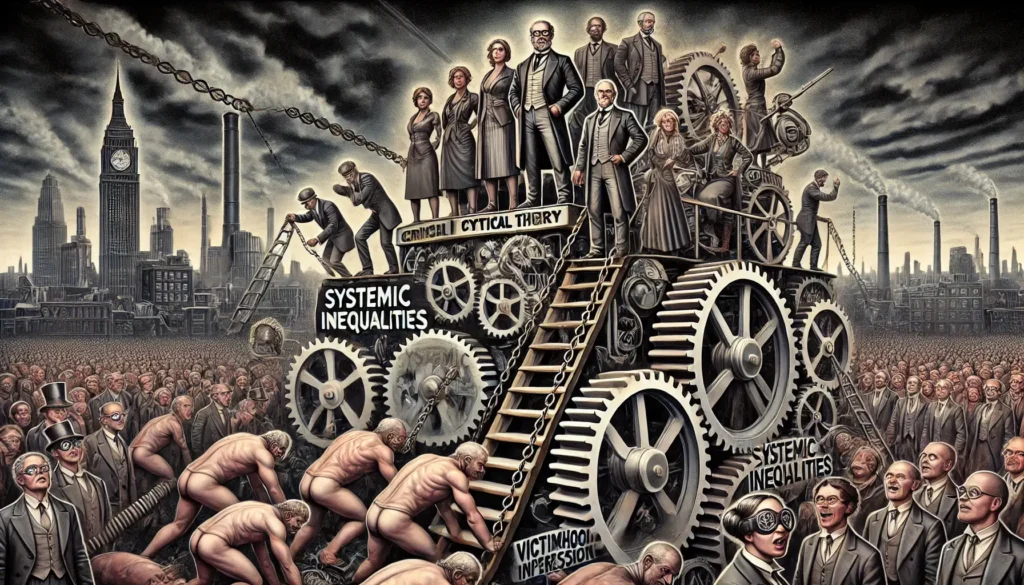Systemic Inequalities – When Every Gap Becomes Oppression
From Unequal Outcomes to Universal Guilt
Not long ago, inequality meant economic gaps — the rich versus the poor, the haves versus the have-nots. Today, the term has been broadened into systemic inequalities: any difference in group outcomes, across race, gender, sexuality, or ability, is framed as proof of injustice.
This shift turns every statistic into a moral indictment. If the numbers don’t line up, the system must be rigged. The solution? Endless reforms, quotas, and bureaucracy — but rarely an honest look at deeper causes.
Table of contents
What Are Systemic Inequalities?
In activist theory, systemic inequalities mean persistent gaps in outcomes between identity groups, caused not by individual choices but by hidden structures of discrimination.
Examples often cited:
- Wage differences between men and women.
- Underrepresentation of minorities in leadership roles.
- Educational test gaps across racial or class lines.
- Health disparities between groups.
By definition, any disparity is treated as evidence of systemic bias — even if alternative explanations exist.
Buzzwords of Systemic Inequalities
The narrative is reinforced by a set of familiar slogans:
- “Representation” – Every group must appear in equal numbers in all areas.
- “Closing the gaps” – Measured not by improvement, but by identical outcomes.
- “Level the field” – Often code for quotas or preferential treatment.
- “Disparities” – Differences automatically reframed as discrimination.
The words sound fair, but they turn statistics into weapons.
How the Concept Shows Up in Practice
- In Education: Admissions policies engineered to balance demographics.
- In Workplaces: Hiring quotas and promotions to “correct” disparities.
- In Politics: Legislation designed around identity categories instead of universal rights.
- In Healthcare: Treatment policies prioritising some groups over others in the name of equity.
Once adopted, the framework creates permanent bureaucracies tasked with monitoring inequality.
Why Institutions Promote the Narrative
- Academics publish endless studies highlighting disparities as proof of systemic failure.
- Activists use statistics to demand funding, reform, or new laws.
- Corporations adopt equality pledges to polish their brand, often at minimal cost.
- Politicians gain moral credibility by promising to “fix the system,” while ignoring harder structural issues like housing or wages.
Systemic inequalities provide a renewable resource: the numbers will never be perfectly equal, so the narrative never ends.
The Consequences of the Framework
- Perpetual grievance: Every gap becomes proof of injustice, keeping outrage alive.
- Division: Groups compete for recognition as the most disadvantaged.
- Bureaucracy: Governments and corporations spend more on managing data than fixing real problems.
- Distraction: Class and wealth inequality — the biggest gaps of all — get buried under identity metrics.
The irony? A framework meant to fight inequality often entrenches it.
Why It Matters
Systemic inequalities sound like a call for fairness. But in practice, the concept locks society into an endless loop of measuring, comparing, and blaming — without solving the underlying problems.
Real inequalities, especially economic ones, remain unaddressed while institutions compete to polish their “equity” credentials.
From Numbers to Narratives
Inequality is real, but systemic inequalities reframe every gap as oppression, every disparity as proof of injustice, and every statistic as a political tool.
The result? A world where numbers matter more than people, bureaucracy thrives, and the system never stops policing itself.
FAQ: Systemic Inequalities
What are systemic inequalities?
Persistent differences in outcomes between identity groups, framed as proof of structural injustice.
Why are they controversial?
Because disparities are automatically assumed to be caused by discrimination, ignoring other factors.
How do systemic inequalities show up in practice?
Through quotas, identity-based policies, and bureaucracies built to track outcomes.
Who benefits from this framework?
Academics, activists, politicians, and corporations that profit from managing inequality narratives.
What’s the risk?
It fuels division, entrenches bureaucracy, and distracts from deeper economic inequality.



